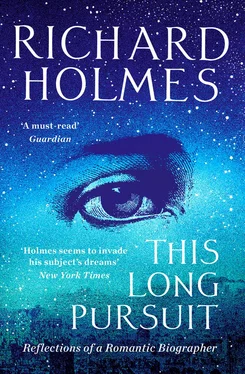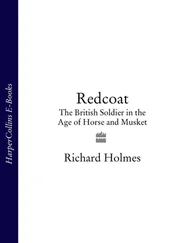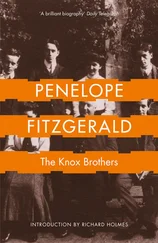What happy and what mournful hours, since last
I skimm’d the smooth thin stone along thy breast,
Numbering its light leaps! yet so deep imprest
Sink the sweet scenes of childhood, that mine eyes
I never shut amid the sunny ray,
But straight with all their tints thy waters rise,
Thy crossing plank, thy marge with willows grey,
And bedded sand that vein’d with various dyes
Gleam’d through thy bright transparence!
Then there was the time as a small boy that he ventured into a deep cave near the banks of the River Otter. This was a haunted place known locally as ‘the Pixies’ Parlour’. Greatly daring, he carved his initials in the stone at the very back. A decade later he returned as a young man, to crawl in again and admire these initials, as he put it, ‘cut by the hand of childhood’. After another two decades, now nearly forty, the physical fact had become a metaphysical one. In a poem, ‘A Tombless Epitaph’ (1809), he compared his crawling into this dark cave with his later exploration of the cave of philosophy. The mineral glitter of this reimagined mental cave, the cave of his own mind and imagination, adds a whole new dimension to the ‘caverns measureless to man’ of ‘Kubla Khan’:
… Yes, oft alone,
Piercing the long-neglected holy Cave,
The haunt obscure of old Philosophy,
He bade with lifted torch its starry wall
Sparkle, as erst they sparkled to the flame
Of odorous lamps tended by Saint and Sage.
When I crawled into that same sandstone cave almost exactly two hundred years later, I made a surprising discovery. Raising my trembling lighter, I spied at the very back of the cave the carved initials ‘STC’.
What actually happened, as recorded in my notebook, was that I was so delighted that I sprang up and almost knocked myself out on the low stone ceiling. A large sliver of sandstone came down. As I crouched there, seeing stars in the darkness, I suddenly realised that the cave stone was too soft to retain the original initials. Something else had happened to them, equally interesting. They had been recarved . I reflected on the implications of this idea in my notebook, and my eventual footnote read: ‘Such carvings and recarvings of his initials, ceremoniously repeated by generation after generation of unknown memorialists, suddenly seemed to me like a symbol of the essentially cumulative process of biography itself.’
Another informative place for me was Coleridge’s house at Greta Hall, Keswick, where he lived close to the Wordsworths at Grasmere between 1800 and 1804. Suitably enough, it had once been an observatory. The top-floor study has astonishing views of Derwentwater and the high fells spreading all round. He would climb out of the window and sit on the ‘leads’, or flat roof, gazing at the expanse and writing. One eloquent letter begins: ‘From the leads on the house top of Greta Hall, Keswick, Cumberland, at the present time in the occupancy and usufruct-possession of ST Coleridge Esq, gentleman poet and Philosopher in a mist.’ Another offers to send his friend, the young chemist Humphry Davy, the whole Lake District panorama wrapped up in a single pill of opium.
Here he wrote the famous ‘Dejection: an Ode’ (1802), which we now know exists in two drafts, the first as a secret love letter to Sara Hutchinson; the second as a formal ode on the powers of Nature and the Imagination to heal personal grief and depression. Sara was the sister of Wordsworth’s wife Mary Hutchinson; no melting Muse, but a small, handsome, capable woman who strode about the fells, looked after the Wordsworth children, and copied both poets’ manuscripts. She had a determined chin, kindly eyes and thick auburn hair. Coleridge (who had married in 1795) had fallen fatally in love with her at first sight in 1799, and given her the dreamy soubriquet ‘Asra’ in his notebooks and poetry.
There she remains as a fantasy figure for the next twenty years, though she never quite went to bed with him. Instead she did secretarial work, accompanied him on walks, nursed him when ill, and tried to prevent him taking opium, which led to their eventual estrangement in 1812.
In the formal ode, Sara is simply an unnamed ‘virtuous Lady’. In the draft verse letter (not published in full until 1988) she is ‘O Sister! O Beloved! … dear Sara … My Comforter! A Heart within my Heart.’ In a memorable bird image, Coleridge also describes her voluptuously as ‘nested with the Darlings of [her] Love’, and feeling in her embracing arms
Even what the conjugal & mother Dove
That borrows genial warmth from those she warms,
Feels in her thrill’d wings, blessedly outspread! …
Here too, in pursuing him, I had an instructive experience. I discovered that Greta Hall had become a small girls’ boarding school, so I wrote to the headmistress asking permission to visit. It turned out that Coleridge’s study on the top floor was now the sixth-form dormitory. Accordingly I was granted a half-hour afternoon inspection, under Matron’s watchful eye, while the girls were safely away, out in the fields playing hockey.
After we had inspected the room, I asked Matron if I might climb out of the dormitory window onto the flat roof, where Coleridge had often sat writing. As I stood examining the magnificent view, and thinking of his secret beloved Asra, I suddenly saw at my feet two bottles of Vladivar vodka, and a box of Black Russian cigarettes carefully wrapped in cellophane against the weather.
When I climbed back in, Matron asked if I had found ‘anything biographically interesting’. As I prepared to answer – ‘A biographer is an artist upon oath’ – an angelic-looking blonde sixth-former appeared in the doorway behind Matron, and fixing me with a mute appeal, silently shook her head. ‘Yes, Matron,’ I replied gravely. ‘Clear signs of artistic inspiration.’ Still standing behind Matron, the girl mouthed a silent ‘Thank-you’ at me, spread her arms in a strange airborne gesture, and slipped away.
Of course I felt the subversive spirit of Coleridge’s Asra had been in close attendance. Yet, on reflection, not merely as the angel, but also as the kindly Matron, who possibly knew more than she was letting on. This reminded me that Asra was both angel and nurse to Coleridge. Much expanded, almost to the length of a short story (named, after one of Coleridge’s own poems, ‘An Angel Visitant’), this incident went down in the left-hand side of my notebook as a warning against both the charms and the perils of romanticising. Places of ‘inspiration’ might genuinely retain something of their force over time, and it was vital to capture this. But the biographer should also be on guard against vodka.
A different kind of alchemy transfused Coleridge’s friendship with the young chemist Humphry Davy. When they were both in their twenties, Coleridge volunteered to take part in Davy’s early experiments with the intoxicating nitrous oxide (laughing gas) at the Bristol Pneumatic Institute. Davy’s scientific account of gas euphoria turned out to have extraordinary parallels with Coleridge’s poetic account of opium hallucinations, as described in ‘Kubla Khan’.
‘I lost all connections with external things,’ recorded Davy, ‘trains of vivid visible Images rapidly passed through my mind … With the most intense belief and prophetic manner, I exclaimed … “Nothing exists, but Thoughts! – the Universe is composed of impressions, ideas, pleasures and pains!” … I was now almost completely intoxicated … I seemed to be a sublime being, newly created and superior to other mortals …’
Davy and Coleridge also corresponded about the nature of pain, and the possibilities of gas-based anaesthetics for use in surgical operations. Coleridge later went to his friend’s chemistry lectures, and enthused: ‘I attended Davy’s lectures to enlarge my stock of metaphors … Every subject in Davy’s mind has the principle of Vitality. Living thoughts spring up like Turf under his feet …’ To Davy himself he made a crucial connection: ‘Science being necessarily performed with the passion of Hope, it was Poetical .’
Читать дальше












